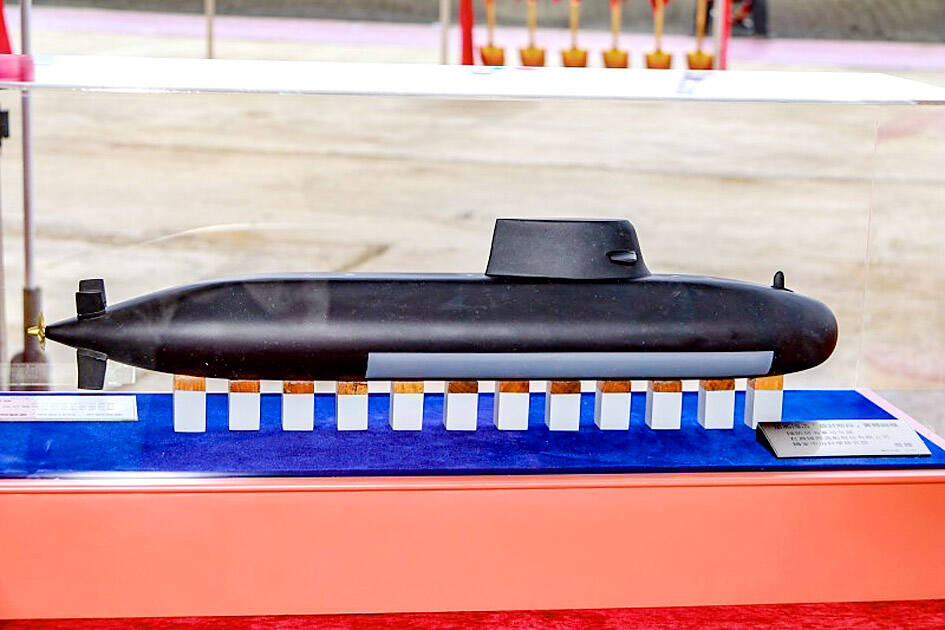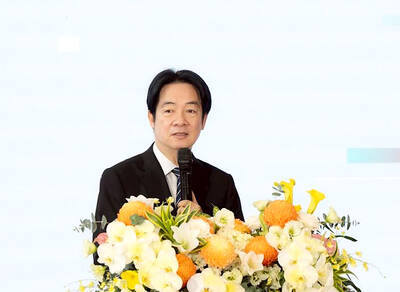A prototype of Taiwan’s first locally built submarine is set to begin testing in September, marking a milestone in the nation’s Indigenous Defense Submarine program, CSBC Corp, Taiwan (台船) chairman Cheng Wen-lon (鄭文隆) said yesterday.
The construction of the prototype has continued around the clock after overcoming a series of difficulties thanks to the cooperation of the Naval Shipbuilding Development Center, the navy’s 256th Submarine Squadron and a CSBC task force, Cheng said.
The government has allocated a NT$49.36 billion (US$1.61 billion) budget over seven years (2019 to 2025) to build a prototype, hoping to launch an indigenous submarine building program that would make Taiwan less dependent on other nations to procure the vessels.

Photo courtesy of the Ministry of National Defense
More than 40 percent of the submarine, including its airtight doors, water conversion system, hydraulic system and silent air-conditioning system, is being manufactured locally, a source familiar with the program said.
Currently, six hull sections have been completed, with only the sail cover section left to be completed, the source said, adding that the ultimate goal is for a submarine cluster to take root in Taiwan so more submarines can be built.
Some “red zone” technologies beyond Taiwan’s submarine design and building capability, such as its diesel engine, torpedo tubes and other combat equipment, have been procured from overseas, the source said.
The Ministry of National Defense has divided the hardware and technologies Taiwan needs for its submarines into red, yellow and green categories, with “red” parts needing to be imported, “yellow” parts that might possibly be made locally and “green” parts that can easily be made in Taiwan.

MISINFORMATION: The generated content tends to adopt China’s official stance, such as ‘Taiwan is currently governed by the Chinese central government,’ the NSB said Five China-developed artificial intelligence (AI) language models exhibit cybersecurity risks and content biases, an inspection conducted by the National Security Bureau (NSB) showed. The five AI tools are: DeepSeek, Doubao (豆包), Yiyan (文心一言), Tongyi (通義千問) and Yuanbao (騰訊元寶), the bureau said, advising people to remain vigilant to protect personal data privacy and corporate business secrets. The NSB said it, in accordance with the National Intelligence Services Act (國家情報工作法), has reviewed international cybersecurity reports and intelligence, and coordinated with the Ministry of Justice Investigation Bureau and the National Police Agency’s Criminal Investigation Bureau to conduct an inspection of China-made AI language

LIMITS: While China increases military pressure on Taiwan and expands its use of cognitive warfare, it is unwilling to target tech supply chains, the report said US and Taiwan military officials have warned that the Chinese People’s Liberation Army (PLA) could implement a blockade within “a matter of hours” and need only “minimal conversion time” prior to an attack on Taiwan, a report released on Tuesday by the US Senate’s China Economic and Security Review Commission said. “While there is no indication that China is planning an imminent attack, the United States and its allies and partners can no longer assume that a Taiwan contingency is a distant possibility for which they would have ample time to prepare,” it said. The commission made the comments in its annual

CHECKING BOUNDARIES: China wants to disrupt solidarity among democracies and test their red lines, but it is instead pushing nations to become more united, an expert said The US Department of State on Friday expressed deep concern over a Chinese public security agency’s investigation into Legislator Puma Shen (沈伯洋) for “secession.” “China’s actions threaten free speech and erode norms that have underpinned the cross-strait ‘status quo’ for decades,” a US Department of State spokesperson said. The Chongqing Municipal Public Security Bureau late last month listed Shen as “wanted” and launched an investigation into alleged “secession-related” criminal activities, including his founding of the Kuma Academy, a civil defense organization that prepares people for an invasion by China. The spokesperson said that the US was “deeply concerned” about the bureau investigating Shen

‘TROUBLEMAKER’: Most countries believe that it is China — rather than Taiwan — that is undermining regional peace and stability with its coercive tactics, the president said China should restrain itself and refrain from being a troublemaker that sabotages peace and stability in the Indo-Pacific region, President William Lai (賴清德) said yesterday. Lai made the remarks after China Coast Guard vessels sailed into disputed waters off the Senkaku Islands — known as the Diaoyutai Islands (釣魚台) in Taiwan — following a remark Japanese Prime Minister Sanae Takaichi made regarding Taiwan. Takaichi during a parliamentary session on Nov. 7 said that a “Taiwan contingency” involving a Chinese naval blockade could qualify as a “survival-threatening situation” for Japan, and trigger Tokyo’s deployment of its military for defense. Asked about the escalating tensions